CVTE
Carpentry
Jeff Wildrick, Academy A Administrator – Ext. 291
Course & Program of Studies
Statement of Purpose
The carpentry industry continues to thrive, offering rewarding careers for skilled professionals. At Greater New Bedford Regional Vocational Technical High School, our Carpentry program provides students with the knowledge and skills needed to succeed in this dynamic field.
Our Program Offers:
- Comprehensive Training: Students learn a wide range of carpentry skills, including residential construction, commercial construction, and millwork.
- Hands-On Experience: Practical, hands-on training in our well-equipped shop.
- Industry-Relevant Curriculum: Our curriculum aligns with the latest industry standards and best practices.
- Safety Training: Students receive comprehensive safety training to ensure a safe working environment.
- Career Pathways: Graduates are prepared for careers as carpenters, construction supervisors, or business owners.
By joining our Carpentry program, you’ll be well-prepared to enter the workforce and contribute to the construction industry.
Exploratory Program
The Freshman Carpentry Exploratory course provides a foundational understanding of the carpentry trade. Students will gain hands-on experience with basic carpentry tools and techniques, including:
- Tool Safety and Usage: Learning to use tools safely and effectively.
- Measurement and Math Skills: Developing skills in measuring, calculating, and solving basic math problems.
- Building Materials: Identifying and understanding the properties of various building materials.
- Construction Basics: Learning fundamental construction techniques, such as framing, cutting, and joining.
- Blueprint Reading: Interpreting basic blueprints and construction drawings.
Through these experiences, students will develop a solid foundation in carpentry and be prepared to advance to more complex projects in their sophomore year.
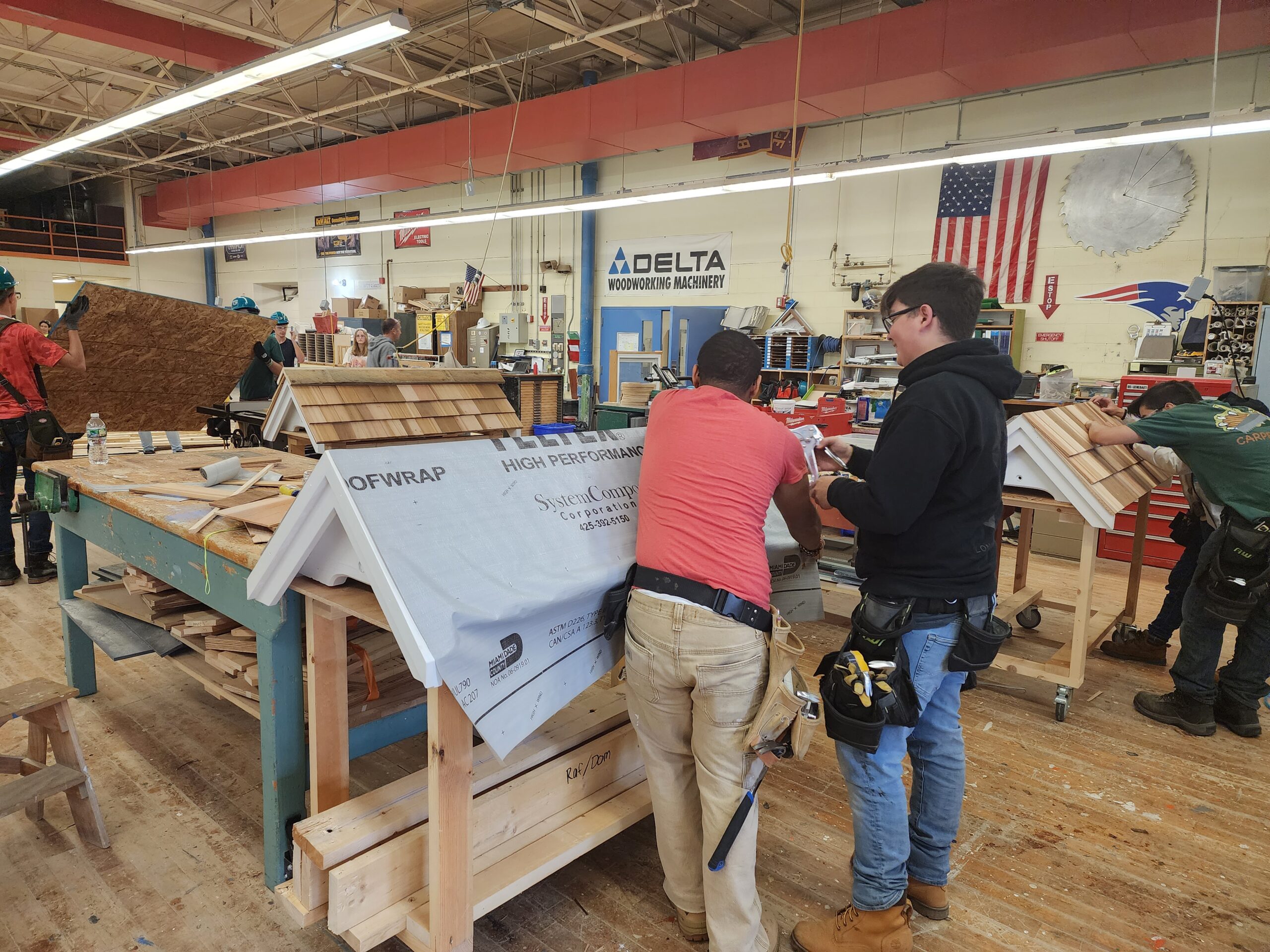
Freshman Program
This introductory carpentry course provides students with a strong foundation in woodworking skills and safety practices.
Core Topics:
Safety:
- Importance of safety in the shop environment
- Personal protective equipment (PPE)
- Tool safety and maintenance
- Emergency procedures
Hand Tool Skills:
- Using hand tools (saws, hammers, chisels, planes)
- Measuring and marking techniques
- Woodworking joints (mortise and tenon, dovetail, etc.)
Power Tool Operations:
- Safe operation of power tools (saws, drills, sanders, routers)
- Tool maintenance and sharpening
- Understanding tool capabilities and limitations
Blueprint Reading and Interpretation:
- Reading and interpreting basic blueprints and drawings
- Understanding dimensions, tolerances, and symbols
- Creating simple shop drawings
Woodworking Projects:
- Building various woodworking projects (e.g., boxes, shelves, furniture)
- Applying woodworking techniques and skills
- Finishing techniques (sanding, staining, painting)
Computer-Aided Design and Manufacturing (CAD/CAM):
- Use basic CAD/CAM software
- Basic CNC machine operation
By the end of this course, students will be able to:
- Use hand and power tools safely and effectively.
- Read and interpret blueprints and drawings.
- Apply woodworking techniques to create various projects.
- Understand the principles of design and construction.
This course provides a solid foundation for further studies in carpentry and related fields. Students will develop the skills and knowledge needed to succeed in the construction industry.
Sophomore Program
This course is designed to expand upon the foundational carpentry skills acquired in Grade 9. Students will delve into advanced techniques, including woodworking lathe operation, cabinetry construction, countertop fabrication (both laminate and solid surface), interior trim installation, interior finishing, and architectural millwork.
Core Competencies
- Technical Skills:
- Mastery of hand and power tool operation
- Proficiency in CNC router operation with AlphaCam software and Cabinet Vision
- Skillful execution of carpentry projects aligned with the Career Connections Project Book 2 and Massachusetts 2017 VTE Carpentry Frameworks
- Safety Practices:
- Adherence to OSHA 10 Construction safety standards
- Problem-Solving and Critical Thinking:
- Ability to interpret architectural drawings and blueprints
- Effective planning and execution of carpentry projects
Course Objectives
Upon successful completion of this course, students will be able to:
- Demonstrate proficiency in advanced woodworking techniques.
- Safely operate a variety of hand and power tools, including CNC routers.
- Interpret and apply architectural drawings and blueprints.
- Plan, layout, and construct complex carpentry projects.
- Develop strong problem-solving and critical thinking skills.
- Prepare for entry into a carpentry apprenticeship program.
Certification and Career Pathways
Successful completion of this course, including a written exam, will result in the issuance of an OSHA 10 Construction card and eligibility for the Carpenters Union Apprenticeship Program.

Sophomore Related
Residential Construction Technology
This course provides a solid foundation in carpentry, focusing on building science, design, and construction techniques.
Key Topics:
- Blueprint Reading:
- Interpreting architectural drawings and blueprints.
- Understanding symbols, dimensions, and specifications.
- Building Codes and Standards:
- Adhering to building codes and safety regulations.
- Understanding energy efficiency and sustainability standards.
- Foundation Systems:
- Types of foundations (slab, crawl space, basement)
- Foundation design and construction
- Footing and wall construction
- Framing:
- Framing techniques for walls, floors, and roofs
- Understanding load-bearing and non-load-bearing walls
- Using framing tools and equipment
- Roof Framing:
- Rafter design and layout
- Truss systems
- Roof sheathing and covering
- Stair Building:
- Stair layout and design
- Cutting and installing stair components
- Material Estimation:
- Calculating material quantities for construction projects
- Understanding material specifications and costs
- Mathematical Applications:
- Using geometry and trigonometry to solve construction problems
- Calculating areas, volumes, and angles
- Estimating material quantities
Practical Applications:
- Hands-on Projects: Building projects in a shop or on a construction site.
- Tool Usage: Learning to use a variety of hand and power tools safely and efficiently.
- Safety Practices: Adhering to safety regulations and using personal protective equipment.
- Problem-Solving: Identifying and solving construction problems.
- Communication Skills: Communicating effectively with other tradespeople and clients.
By the end of this course, students will have a solid understanding of carpentry principles and techniques. They will be able to read blueprints, estimate materials, and construct various building components. Additionally, they will develop strong problem-solving, critical thinking, and communication skills.
Sophomore Related 2
Basic Builders Math
This course provides a comprehensive foundation in the mathematical principles underlying residential construction. By exploring core concepts in arithmetic, algebra, geometry, and trigonometry, students develop the skills necessary to tackle a wide range of construction challenges.
Key Topics:
- Blueprint Interpretation: Students learn to decipher architectural and engineering drawings, including floor plans, elevations, and cross-sections.
- Measurement and Estimation: Accurate measurement and estimation techniques are essential in construction. Students practice calculating areas, volumes, and dimensions of various construction elements.
- Material Science and Cost Estimation: The course covers the properties, applications, and costs of common construction materials, such as wood, concrete, steel, and masonry.
- Structural Principles: Understanding structural elements like beams, columns, and foundations is crucial. Students explore concepts of load-bearing capacity, stress, and strain.
- Practical Problem-Solving: Through real-world exercises and case studies, students apply mathematical principles to solve construction-related problems.
By the end of the course, students will be well-prepared for further education or entry-level positions in the residential construction industry. The emphasis on both theoretical knowledge and practical application equips students with the skills needed to succeed in this field.
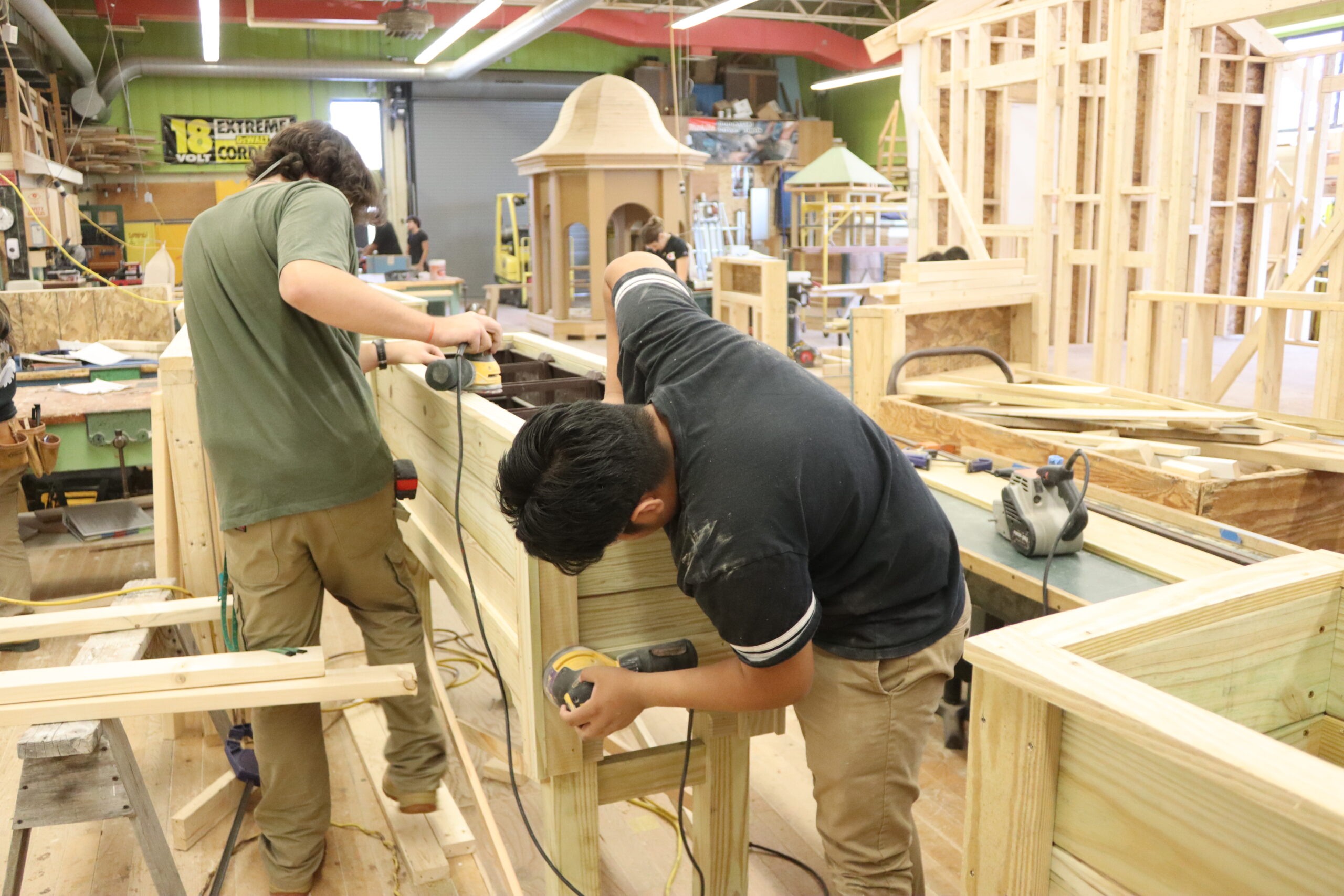
Junior Program
This foundational course provides students with a strong understanding of residential construction principles and safety practices.
Key Topics:
- Safety:
- Safety regulations and standards
- Personal protective equipment (PPE)
- Tool safety and maintenance
- Ladder and scaffold safety
- Tool Usage:
- Hand tools (hammers, saws, chisels, planes)
- Power tools (drills, saws, routers)
- Blueprint Reading:
- Interpreting architectural drawings and blueprints
- Understanding symbols, dimensions, and specifications
- Building Materials:
- Types of wood (lumber, plywood, MDF)
- Fasteners (nails, screws, bolts)
- Building hardware (hinges, locks, handles)
- Construction Techniques:
- Measuring and marking techniques
- Cutting and joining techniques (sawing, drilling, routing)
- Assembly techniques (nailing, screwing, bolting)
- Finishing techniques (sanding, staining, painting)
- Building Codes and Standards:
- Understanding building codes and regulations
- Energy-efficient construction practices
Hands-on Projects:
- Simple Projects: Building small projects like birdhouses, toolboxes, and shelves.
- Framing Projects: Constructing wall and roof frames for model houses and sheds.
- Finishing Projects: Applying finishes to projects, such as staining, painting, and varnishing.
By the end of this course, students will be able to:
- Use hand and power tools safely and effectively.
- Read and interpret blueprints and drawings.
- Apply basic carpentry techniques.
- Understand building codes and safety regulations.
- Communicate effectively with others in the construction industry.
This course provides a solid foundation for further studies in carpentry and prepares students for entry-level positions in the construction industry.
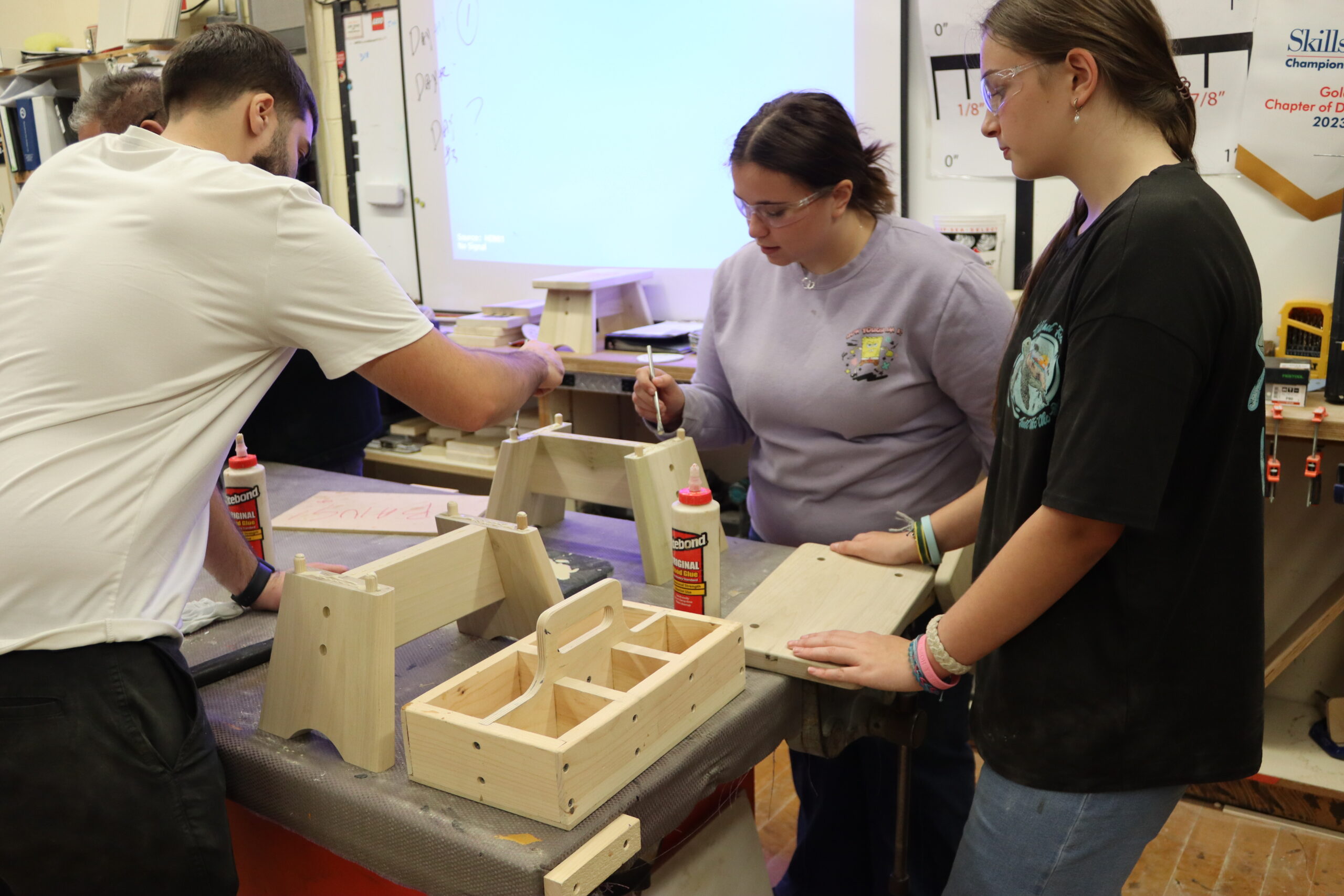
Junior Related
Carpentry Technology
This course builds upon fundamental carpentry skills, delving into advanced concepts and techniques essential for residential construction.
Key Topics:
Building Science:
- Building Codes and Standards: Understanding building codes and regulations.
- Energy Efficiency: Implementing energy-efficient building practices.
- Sustainable Building: Exploring sustainable building materials and techniques.
- Building Physics: Understanding the principles of heat transfer, air flow, and moisture control.
Architectural Drafting:
- Blueprint Reading: Interpreting architectural drawings and blueprints.
- Sketching and Drafting: Creating detailed drawings and plans.
- CAD Software: Using CAD software to create accurate and professional drawings.
Carpentry Techniques:
- Advanced Framing Techniques: Constructing complex framing systems, including roof trusses and wall assemblies.
- Stair Building: Designing and building stairs, including stringers, treads, and risers.
- Door and Window Installation: Installing doors and windows, including framing and finishing.
- Finish Carpentry: Installing trim, molding, and cabinetry.
Mathematical Applications:
- Geometry: Applying geometric principles to calculate angles, distances, and areas.
- Trigonometry: Using trigonometry to solve problems related to roof pitch, stair rise, and run.
- Algebra: Using algebraic equations to calculate material quantities and costs.
By the end of this course, students will be able to:
- Read and interpret architectural blueprints.
- Apply building codes and standards to construction projects.
- Use advanced carpentry techniques to build complex structures.
- Estimate material quantities and costs.
- Solve mathematical problems related to construction.
- Communicate effectively through written and visual means.
This course provides a solid foundation in carpentry and building science, preparing students for careers in construction, carpentry, and related fields.

Junior Related 2
Applied Technical Math I for Carpentry
This course provides a solid foundation in the mathematical principles essential for success in the residential construction industry. By combining theoretical knowledge with practical applications, students will develop the skills needed to solve construction-related problems, estimate material quantities, and understand building codes and standards.
Key Topics:
Fundamental Mathematics Review:
- Arithmetic operations
- Algebraic equations
- Geometric concepts (angles, triangles, circles)
- Trigonometric functions (sine, cosine, tangent)
Blueprint Reading and Interpretation:
- Understanding architectural drawings and blueprints
- Identifying symbols, dimensions, and specifications
- Extracting relevant information for construction purposes
Measurement and Estimation:
- Units of measurement (imperial and metric)
- Converting between units
- Calculating areas, volumes, and perimeters
- Estimating material quantities (lumber, concrete, drywall)
Construction Materials and Costs:
- Properties of construction materials (wood, steel, concrete)
- Material selection and pricing
- Estimating project costs based on material quantities and labor hours
Structural Principles:
- Load-bearing capacity of structural elements
- Stress and strain analysis
- Foundation design and construction
- Framing techniques (walls, floors, roofs)
- Building codes and regulations
Practical Applications:
- Problem-solving: Applying mathematical principles to solve real-world construction problems.
- Material Take-offs: Calculating material quantities for construction projects.
- Cost Estimating: Estimating project costs based on material and labor costs.
- Building Code Calculations: Verifying compliance with building codes and standards.
- Construction Drawings: Creating and interpreting construction drawings.
By the end of this course, students will be able to:
- Read and interpret blueprints accurately.
- Perform calculations related to construction projects.
- Estimate material quantities and project costs.
- Understand the principles of structural design.
- Apply mathematical concepts to real-world construction scenarios.
This course provides a strong foundation in construction mathematics, preparing students for further education or careers in the construction industry.
Senior Program
This senior-level carpentry course focuses on advanced techniques and skills required for commercial construction.
Key Areas of Focus:
Interior Construction:
- Drywall Installation: Techniques for hanging, taping, and finishing drywall.
- Metal Framing: Installing metal studs and tracks for walls and ceilings.
- Acoustical Ceiling Installation: Installing acoustic ceiling tiles and grids.
- Commercial Door and Frame Installation: Installing commercial doors and frames.
- Interior Trim: Installing baseboards, moldings, and other interior trim.
Exterior Construction:
- Siding Installation: Installing various types of siding (vinyl, fiber cement, wood).
- Trim Work: Installing exterior trim, such as window and door trim, fascia, and soffit.
- Roofing: Understanding roofing systems and installation techniques.
Construction Estimating and Project Management:
- Reading Blueprints: Interpreting architectural drawings and specifications.
- Estimating Materials: Calculating material quantities for construction projects.
- Project Scheduling: Planning and scheduling construction projects.
- Cost Estimating: Estimating labor and material costs.
Hands-On Experience:
- On-Site Projects: Participating in real-world construction projects.
- Shop Projects: Building and assembling components in a controlled shop environment.
- Industry Certifications: Preparing for and obtaining industry certifications (e.g., OSHA 10-hour, OSHA 30-hour).
By the end of this course, students will be well-prepared for careers in the construction industry. They will have the skills and knowledge to work as carpenters, construction foremen, or project managers. Additionally, the course will provide a solid foundation for further education in construction management or engineering.
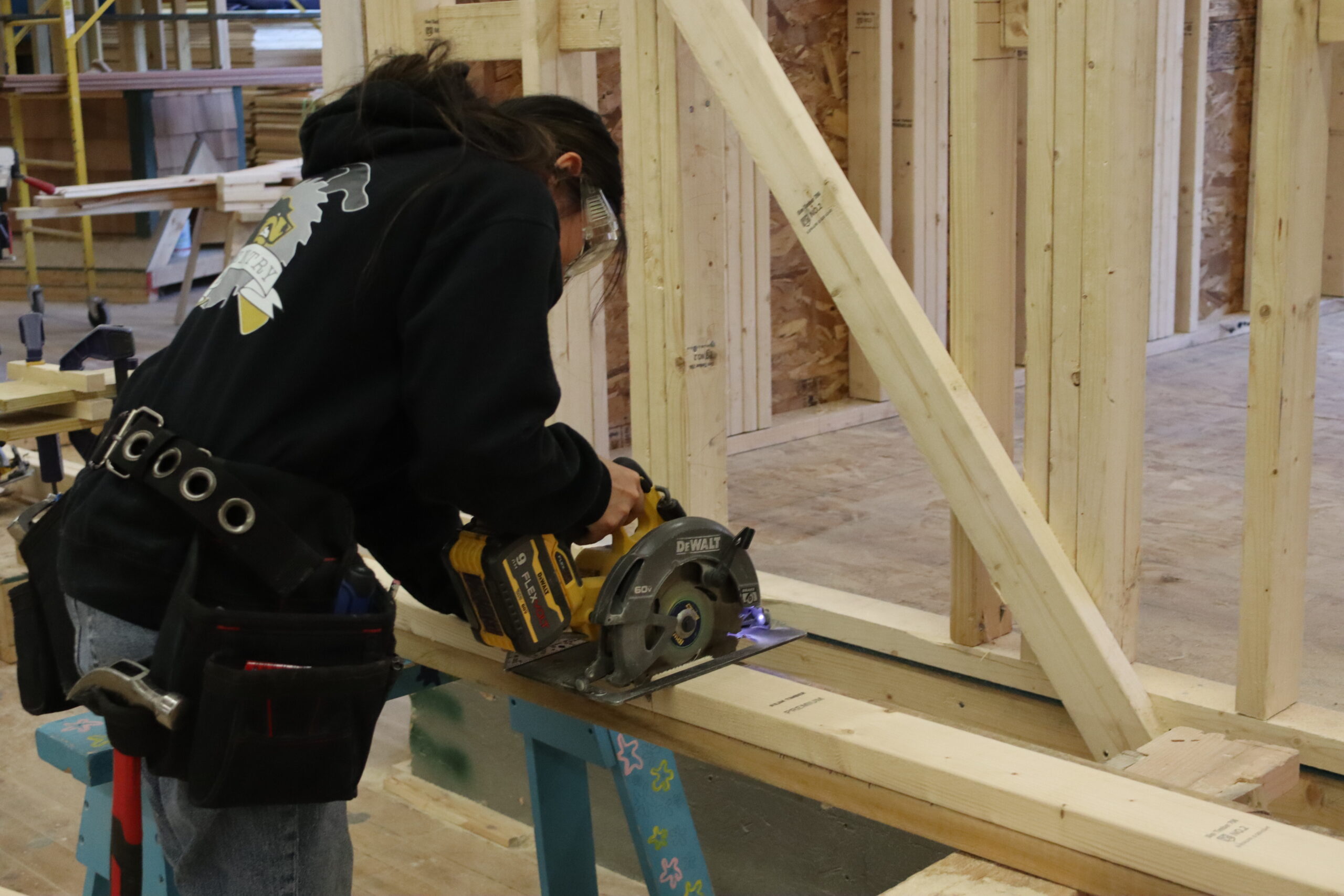
Senior Related
Analytical Mathematics
This senior-level carpentry course builds upon the foundational skills and knowledge acquired in previous years, focusing on advanced construction techniques, project management, and business skills.
Key Topics:
- Advanced Framing Techniques:
- Complex framing systems (trussed roofs, cathedral ceilings)
- Floor system design and installation
- Wall framing and sheathing
- Roof framing and roofing systems
- Building Codes and Standards:
- Understanding building codes and regulations
- Energy-efficient building practices
- Safety regulations and procedures
- Construction Estimating and Budgeting:
- Estimating material quantities and costs
- Developing project budgets
- Understanding labor costs and productivity
- Construction Project Management:
- Project planning and scheduling
- Site supervision and management
- Quality control and inspection
- Business Skills:
- Entrepreneurship and self-employment
- Marketing and sales
- Business planning and financial management
Senior Project:
- Project Planning: Developing a detailed project plan, including a timeline and budget.
- Blueprint Reading and Interpretation: Analyzing architectural blueprints and specifications.
- Material Estimation and Purchasing: Calculating material quantities and sourcing materials.
- Construction Process: Overseeing the construction process, including framing, roofing, siding, and interior finishes.
- Project Documentation: Documenting the project, including photos, drawings, and a final report.
By the end of this course, students will be well-prepared for careers in the construction industry. They will have the skills and knowledge to manage construction projects, estimate costs, and ensure quality workmanship. Additionally, they will be able to apply critical thinking and problem-solving skills to overcome challenges and achieve project goals.
Senior Related 2
Carpentry Technology – Elective
The Senior Carpentry Technology class provides a comprehensive theoretical foundation in carpentry and construction principles. This course is designed to equip students with the knowledge and skills necessary for success in the field.
Key Topics:
- Blueprint Reading: Students develop the ability to interpret architectural and engineering drawings, understanding symbols, dimensions, and construction details.
- Building Codes and Regulations: Students learn about local, state, and national building codes and regulations, ensuring compliance and safety in construction projects.
- Construction Materials and Techniques: Students explore the properties, applications, and techniques for working with various construction materials, including wood, metal, concrete, and composites.
- Safety Procedures: Safety is emphasized throughout the course, with instruction on proper tool usage, hazard identification, and emergency procedures.
- Tool Usage and Maintenance: Students gain proficiency in using a variety of hand and power tools, as well as learning proper maintenance techniques.
- Estimation and Cost Analysis: Students develop skills in estimating material quantities, calculating project costs, and analyzing cost-effectiveness.
- Sustainability and Green Building Practices: Students explore environmentally friendly construction techniques and sustainable material choices.
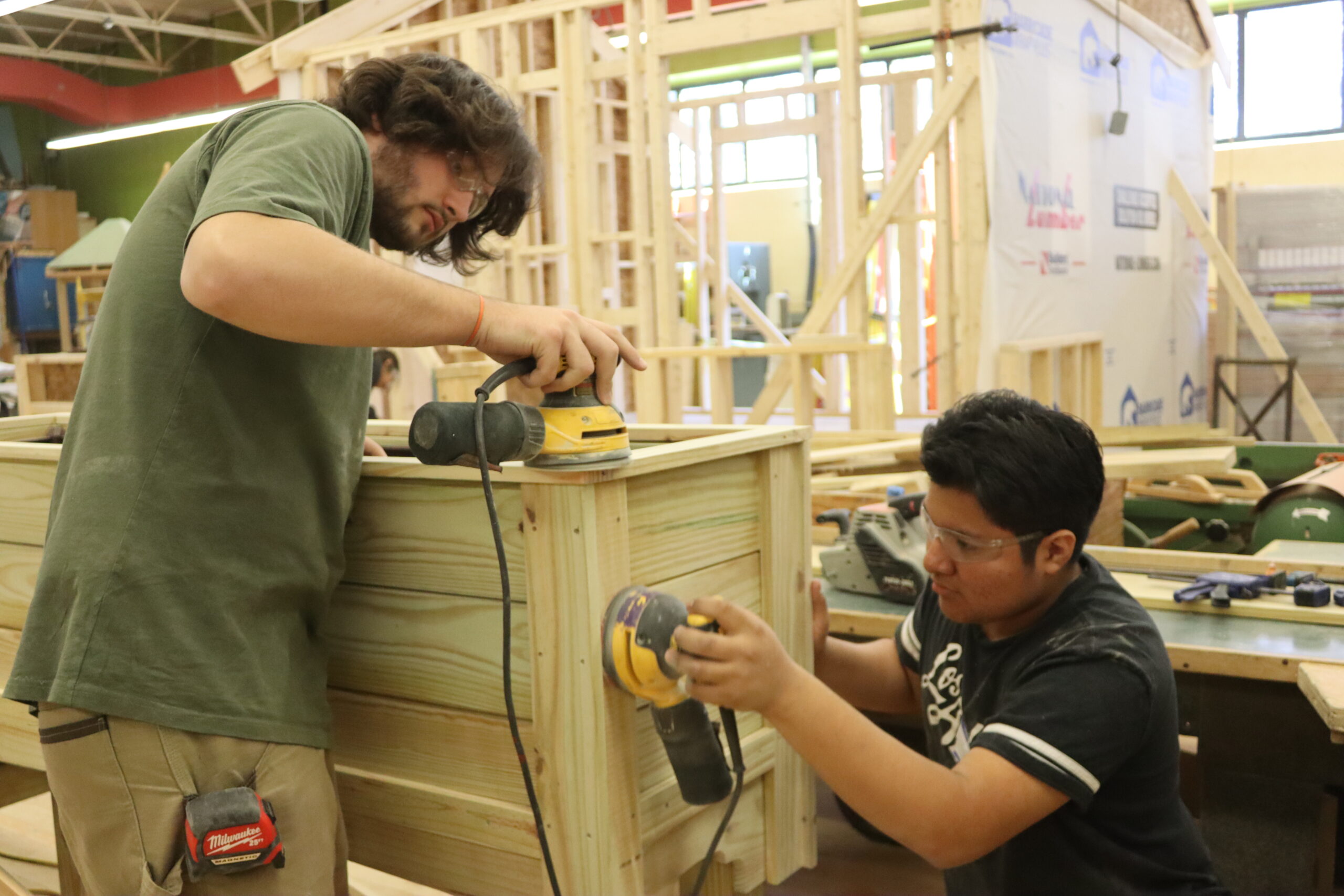
Certifications
- OSHA 10-hour Construction Safety and Health training and certificate
- 1 year credit towards the 3 year (minimum employment) requirement needed to take the CSL, Construction Supervisors License Exam
- 3 certificate towards a 1 year apprenticeship credit in the United Brotherhood of Carpenters and Joiners (students will enter the union as a second year apprentice).
Career Opportunities
- Home Builders
- Construction
- Remodeling Contractors
- Building Material Vendors
- Cabinet Making Shops
- United Brotherhood of Carpenters and Joiners
- Carpenters and Joiners
- Millwrights
- Pile Drivers
- Residential Carpenters
- Interior Systems Carpenters
- Lathers and Drywallers
- Cabinet Makers and Millworkers
- Floor Layers
Post-Secondary Education
- Architecture
- Design
- Civil Engineering
- Carpenters Union
- Apprenticeship Training Center
- Construction Management


